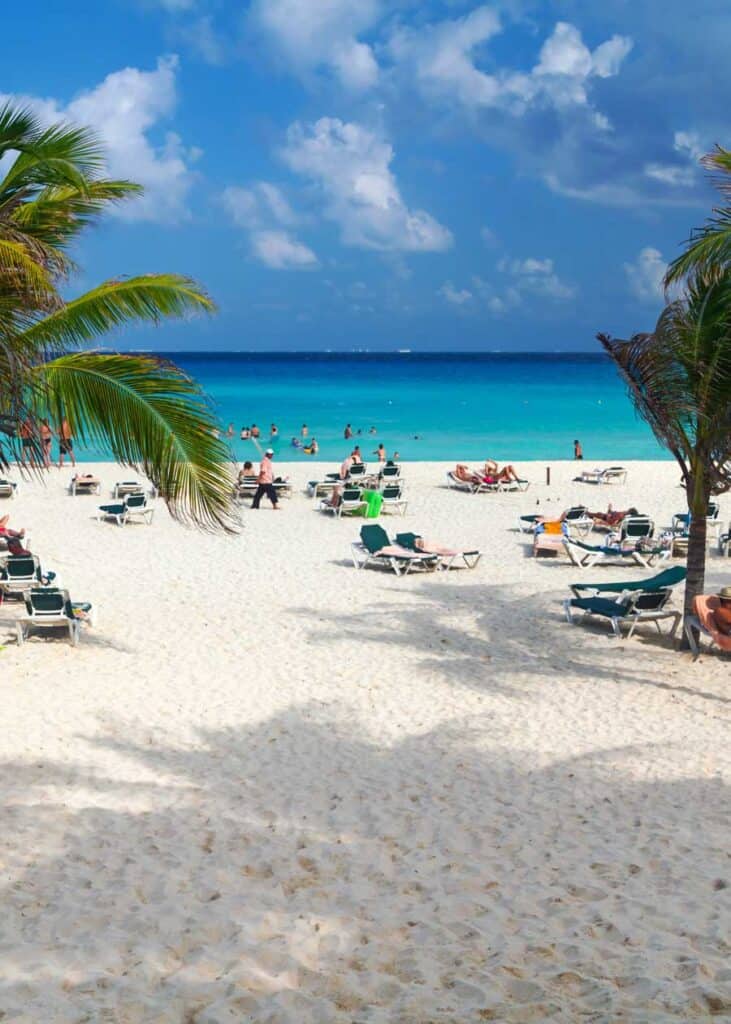Sand flea bites can be a real bummer on the beach. The good news is that you don’t have to let them ruin your vacation! There are numerous ways to both prevent and treat sand flea bites while you’re soaking up the sun.

Table of Contents
1. Identity the Culprit
The first thing to know is that several types of insects and crustaceans get called “sand fleas.”
These include:
- True sand fleas (Tunga penetrans)
- Sand flies (Ceratopogonidae, Tabanidae, or Phlebotominae)
- Sand crabs or sand bugs (Emerita)
- Sand hoppers (Talitrus saltator)
- Chiggers (Trombicula)
Don’t worry! You don’t need to know all of these critters.
Chiggers, for example, don’t even live on the beach; they just get confused with a sand flea species nicknamed “jiggers.”
Here are 8 key differences between chiggers vs jiggers.
Meanwhile, sand crabs and sand hoppers don’t bite humans, so they’re harmless. Here’s the breakdown of actual sand fleas.
There are only two sand flea species that you need to be concerned about: true sand fleas and sand flies.
Sand Flea Bites
True sand fleas are found on the beaches of Central and South America. They look a bit like ticks with round, engorged bellies, and they feed on blood as well.
Female sand fleas are the most dangerous since they burrow in the feet of human hosts to help them lay eggs. Wounds typically start with small, whitish bites that worsen and blacken over time.
If the wounds become infected, they can cause everything from pain and inflammation to debilitating and even life-threatening conditions like gangrene.
If you think that you’ve been bitten by a sand flea, you’ll want to go to the doctor. There’s no way to treat it on your own, and waiting might just make it worse.
Sand Fly Bites
- Sand flies are much less dangerous than sand fleas, but they’re also much more common. They can be found worldwide, and they congregate in warm, humid environments like beaches and botanical gardens. They look like mosquitos.
- Sand fly bites are usually mild. The wounds are small red bumps that can form welts or rashes if aggravated by scratching, and while they can be a real nuisance to your beach day, they don’t usually require medical intervention. You can treat them with a variety of over-the-counter products and home remedies.
2. Prevent Bites (4 Ways)
As they say in the medical biz, the easiest treatment is prevention.
Here are a few ways to avoid getting bitten by sand fleas and sand flies.
Create a Barrier
Bring towels and tents to the beach rather than laying directly on the sand. It’s also a good idea to invest in flip-flops or water shoes.
Any kind of barrier between your feet and the sand will help to prevent opportunistic sand fleas from taking a bite.
Get Off the Ground
Chairs, hammocks, and other kinds of raised platforms can put some much-needed distance between you and the creepy crawlies below.
Just make sure that you’re at least 10 to 15 inches from the ground. Sand fleas can’t jump, but sand flies can.
Skip the Bug Spray
Most commercial insect repellent isn’t really effective against sand fleas. Instead, opt for oils or oil-based products that will create a layer of protection against your skin while also emitting scents that sand fleas don’t like.
Popular bug deterrents include citronella, lemongrass, lavender, and coconut.
You might also consider Deet and marmite as a possible repellent.
Visit the Beach During the Day
Sand flies are most active at dawn and dusk, so if you can, schedule your beach trip for the middle of the day. You’ll be much less likely to encounter them.
You might also want to avoid the beach after a fresh rainfall since they’re attracted to humid and damp conditions.
3. Treat Your Bites
Anyone can get bitten by sand fleas, even people who are being cautious and taking preventative measures.
If you have been bitten by an actual sand flea (Tunga penetrans), you need to see a doctor right away.
In the meantime, try one of these treatments:
- Hydrocortisone products. Hydrocortisone is found in many anti-inflammatory lotions and creams. It can reduce redness, itchiness, swelling, and pain.
- Aloe vera. Aloe vera is a soothing, all-natural remedy for burns, bug bites, dry skin, and more. Many gel-based skincare products contain aloe vera. You can also purchase aloe vera plants or oils for direct topical use.
- Cold. A cold compress can numb hot and itchy skin. Another option is finding creams that contain cooling agents like aloe vera, menthol, or calamine.
- Oatmeal bath. Oatmeal baths have long been a treatment for itchy skin conditions like chicken pox, but you can also use them for sand flea bites. Just make sure that you’re buying colloidal oatmeal and not the instant, ready-to-eat kind.
- Antibiotics. If your bites have gotten infected, you might need a round of antibiotics from the doctor. They can also prescribe or recommend OTC painkillers for particularly severe bites.
These are all recommendations for sand fly bites. Remember that sand flies are the ones that cause small, red, and inflamed bumps on your skin.
If you’ve been bitten by sand fleas, the ones that leave white circles on your feet from being embedded under the skin, you might need real medical attention. A doctor can surgically extract the fleas and prescribe antibiotics to prevent things like gangrene.
Here’s a recording of a live dermpath session, with Jerad Gardner, MD.
One final piece of advice: Don’t scratch! It’s easier said than done, of course, but scratching will only irritate your bites even more. You could also cause or worsen an infection if you break the skin. It’s just not worth the temporary relief from itching.
Sand Flea Bites FAQ
Are sand fleas dangerous?
Most sand fleas are harmless. Some of the critters called “sand fleas” don’t even bite humans at all!
There are only two species to beware of: true sand fleas (Tunga penetrans and sand flies (Ceratopogonidae, Tabanidae, or Phlebotominae).
The former can actually cause life-threatening medical complications.
What do sand fly bites look like?
Sand flies cause small, red, and painful bumps on the skin.
They usually bite around the legs and ankles, but they can strike anywhere, especially if their chosen human is laying flat in the sand. This is why it’s recommended to always lay on a beach towel!
What do sand flea bites look like?
Sand fleas cause wounds on the bottom of the feet and around the toenails. They bite into the skin and burrow there, eventually swelling and causing painful sores.
The skin usually starts white and becomes black as the tissue rots. Infections are common, and they can bring other symptoms as well, including fever, nausea, and difficulty walking.
Some people have actually died from sand flea bites that led to gangrene or other serious conditions like sepsis.
See this video for a first-person account of sand flea bites.
How do I get rid of sand flea bites?
There are many ways to treat sand flea bites. The most common is with over-the-counter creams and lotions containing ingredients like hydrocortisone and aloe vera. These can help with the swelling while also cooling and soothing the site of the bite.
Other treatment options include cold compresses, oatmeal baths, and wearing loose clothes to prevent any friction on your skin.
If your bites have gotten infected, you might need to find a doctor to prescribe some antibodies. A doctor is also recommended if you’ve been bitten by a true sand flea that’s burrowed into your skin. A doctor can extract it.
How can I prevent sand flea bites?
The easiest way to avoid sand fleas is to create barriers between you and them. Bring chairs, towels, and hammocks to the beach rather than plopping directly onto the sand. Wear sandals or water shoes while walking around.
In terms of repellents, most store-bought bug sprays won’t work on sand fleas, so you’ll need to get creative. Look for oil-based products containing ingredients like citronella, lemongrass, lavender, and coconut.
Sand fleas hate those fragrances, and the oil will provide yet another barrier for your skin.
Here are 6 steps to get rid of sand fleas.

Banishing Sand Fleas Once and For All
Nobody likes sand fleas, but until someone figures out a way to get rid of them, we’re stuck with them. Use these tips and tricks to minimize their presence and stay healthy and bite-free during your beach day!
- About the Author
- Latest Posts
Bryan Haines is a co-founder and writer at The Buginator. And is working to make it the best resource for taking back the outdoors from biting, stinging pests.
He also blogs about travel at Storyteller.Travel and photography at Storyteller Tech. Bryan is a partner at Storyteller Media, a publishing company he runs with his wife, Dena.
